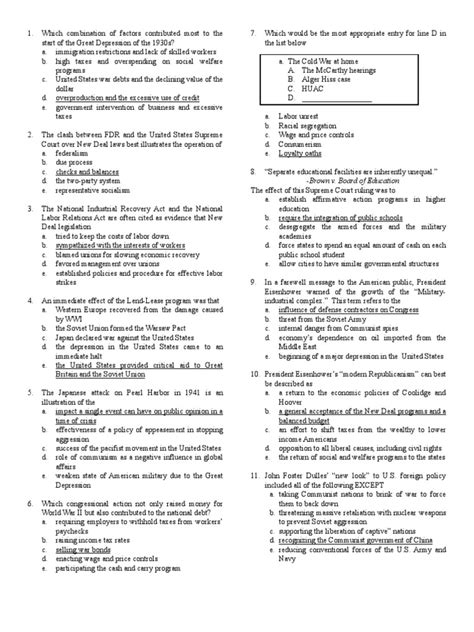Antebellum America and the Causes of the Civil War
Directions: Answer the following questions to the best of your ability. Each question is worth 1 point.

Multiple Choice
-
Which of the following was NOT a major cause of the Civil War?
(a) Slavery
(b) Economic differences between the North and South
(c) States’ rights
(d) British intervention -
Which of the following was a key provision of the Compromise of 1850?
(a) The admission of California as a free state
(b) The organization of New Mexico and Utah as territories without slavery
(c) The passage of the Fugitive Slave Act
(d) All of the above -
Which of the following events is considered to be the “spark” that ignited the Civil War?
(a) The election of Abraham Lincoln
(b) The firing on Fort Sumter
(c) The secession of South Carolina
(d) The Dred Scott decision -
Which of the following was a major goal of the Union during the Civil War?
(a) To preserve the Union
(b) To end slavery
(c) To punish the South
(d) All of the above -
Which of the following was a major goal of the Confederacy during the Civil War?
(a) To preserve slavery
(b) To create a new nation based on states’ rights
(c) To gain recognition from European powers
(d) All of the above
Short Answer
- Describe the main provisions of the Missouri Compromise.
- Explain the significance of the Dred Scott decision.
- Compare and contrast the economies of the North and South in the antebellum period.
- Discuss the role of abolitionists in the growing tensions between the North and South.
- Analyze the impact of the election of Abraham Lincoln on the secession crisis.
Essay
- Discuss the causes of the Civil War. Be sure to consider both the economic, social, and political factors that led to the conflict.
- Analyze the strengths and weaknesses of the Union and Confederate armies during the Civil War.
- Explain the impact of the Civil War on American society. Be sure to consider the political, economic, and social changes that occurred as a result of the war.
Answer Key
Multiple Choice
- (d)
- (d)
- (b)
- (d)
- (d)
Short Answer
- The Missouri Compromise prohibited slavery in new territories north of the 36°30′ parallel, except for Missouri, which was admitted as a slave state. It also provided for the admission of Maine as a free state.
- The Dred Scott decision was a Supreme Court ruling that declared that African Americans were not citizens and could not sue in federal court. It also ruled that the Missouri Compromise was unconstitutional.
- The North’s economy was based on industry and manufacturing, while the South’s economy was based on agriculture, particularly the cultivation of cotton.
- Abolitionists played a key role in raising awareness of the evils of slavery and in advocating for its abolition. Their activities helped to increase tensions between the North and South.
- The election of Abraham Lincoln in 1860 was a major turning point in the secession crisis. Lincoln’s victory convinced many Southerners that the federal government was no longer committed to protecting their interests, and led to the secession of seven Southern states from the Union.
Essay
-
The causes of the Civil War include:
- Economic differences between the North and South
- Slavery
- States’ rights
- The rise of abolitionism
- The election of Abraham Lincoln
-
The strengths and weaknesses of the Union and Confederate armies during the Civil War include:
Union
- Strengths:
- Larger population
- More industrial resources
- Better transportation system
- Weaknesses:
- Lack of experience in warfare
- Divided leadership
Confederacy
- Strengths:
- Better generals
- More experienced soldiers
- Weaknesses:
- Smaller population
- Fewer industrial resources
- Poor transportation system
-
The impact of the Civil War on American society include:
- The end of slavery
- The rise of industrial capitalism
- The growth of the federal government
- The strengthening of national unity
